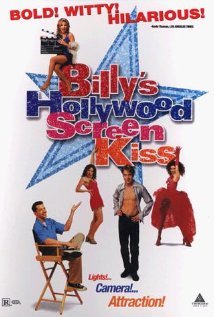“Kiss of Death”

| None | Light | Moderate | Heavy | |
|---|---|---|---|---|
| Language | ||||
| Violence | ||||
| Sex | ||||
| Nudity |
What You Need To Know:
Attempting to revise Hollywood’s Golden Age, BILLY’S HOLLYWOOD SCREEN KISS “re-creates” the Doris Day/Rock Hudson romances but features homosexuals in the leads. Billy is a photographer from Indiana, a place with a lot of straight people. So, he moves to Los Angeles, where he can pursue his dreams of a photography career and a homosexual partner. In LA, a middle-aged homosexual photographer, named Perry, takes Billy under his wing. Perry gives Billy a grant to re-create the great Hollywood screen kisses, but using homosexuals. At a bar, Billy spies a young man named Gabriel. Instantly attracted to Gabriel, Billy him to model for the photo shoot. Gabriel agrees, and soon he and Billy form a friendship, and possibly a romance.
Though whimsical and humorous, this movie has some very crass moments, reinforcing some of the promiscuous and unattractive assumptions that heterosexuals have about homosexuals. Technically, the movie has some clever moments, including dream sequences and a storytelling device using still Polaroid photos. BILLY’S HOLLYWOOD SCREEN KISS tries to feature the homosexual as the everyman looking for love and success. However, it still offers offensive images. It thus may only please the homosexual community.
Content:
(HoHoHo, LLL, SS, NN, A, DD, M) Strong Homosexual worldview with the spoken agenda for more “understanding” & “tolerance” between straights & homosexuals; 36 obscenities & 6 profanities; no violence; homosexual sex implied, homosexual flirting & foreplay depicted, discussion of homosexuality, cross-dressing, & homosexual kissing; brief image of upper female nudity, women in bikini, rear male nudity, & upper male nudity; alcohol use; smoking & marijuana use; and, lying & cheating.
More Detail:
Attempting to revise and revisit Hollywood’s Golden Age, BILLY’S HOLLYWOOD SCREEN KISS “re-creates” the Doris Day/Rock Hudson romances but features gay men in the leads. Although sometimes funny and winsomely told with dream sequences, still Polaroid images and narrative, this movie states at the very beginning that its intention is to create “understanding” and “tolerance” between heterosexuals and homosexuals. Furthermore, it tells the audience that homosexuals are born that way, and it even espouses the fraudulent “Kinsey-scale” of human sexuality.
Billy, played by Sean P. Hayes, narrates the movie and says that he is a photographer from Indiana, a place with a lot of straight people. So, he moves to Los Angeles, where he can pursue his dream of a photography career and find a homosexual partner. In LA, he is strung along by his homosexual lover Fernando. Realizing this is a dead end, he leaves Fernando and is mentored by a middle-aged homosexual photographer, named Perry. Perry gives Billy a grant to shoot a photo spread re-creating the great Hollywood screen kisses but using homosexual men.
At a bar, Billy spies a young man named Gabriel (Brad Rowe, who could be the spitting image of Brad Pitt). Billy is instantly attracted to him and invites him to model for the photo shoot. Gabriel agrees, and soon he and Billy form a friendship. Gabriel tells Billy that he is breaking up with his girlfriend, and soon Billy has dreams that Gabriel could be “coming-out.” In fact, Billy has dreams of his own Hollywood screen kiss with Gabriel. Perry and his romantically challenged roommate Georgianna (Meredith Scott Lynn) warn him not to fall in love with a straight man. When Gabriel goes on a photo shoot for an established homosexual photographer, Billy gets jealous and follows Gabriel to Catalina Island. There, Gabriel expresses his desires, surprising Billy and making for an unexpected ending.
Though whimsical and humorous, this movie has some very crass and presumptuous moments, reinforcing some of the promiscuous and unattractive assumptions that heterosexuals have about homosexuals, and thus is counter productive to its stated goals. At the very start, Billy says that his movie will show no female breasts, but it does on a Polaroid photo. It then shows a man licking another man’s ear. It also shows homosexuals trying to pick up other homosexuals at a homosexual bar. These are stereotypical images of the homosexuals, and they are unsightly to the heterosexual and don’t change any assumptions about promiscuous and unrestrained homosexual behavior. The movie does talk about a Kinsey-scale. Billy states that everyone is born somewhere on the scale where zero means totally heterosexual and six means totally homosexual. Furthermore, the movie advocates that homosexual behavior and attitudes are set at birth, and not learned.
Technically, the movie has some clever moments: the dream sequences, the Polaroid storytelling device and more. One scene displays enormous tension as Gabriel and Billy share a bed. The camera doesn’t cut away from Billy as he decides whether or not to touch a sleeping Gabriel. The camera lingers for what seems like minutes. Writer/director Tommy O’Haver states he was inspired by William Wyler’s THE HEIRESS for the structure ,but comparisons are limited as the movie features drag queens, transvestites, and swishy behavior.
BILLY’S HOLLYWOOD SCREEN KISS tries to feature the homosexuals as the everyman looking for love and success. However, by trying to be marketable to the heterosexual community, it continues to offer offensive images. It may only please the homosexual community.


 - Content:
- Content: 

